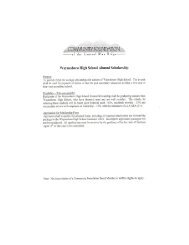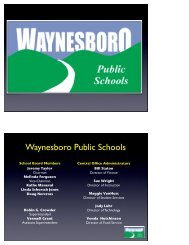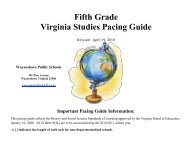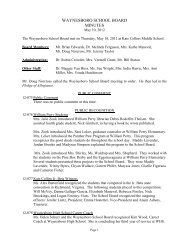Second Grade Reading Pacing Guide - Waynesboro Public Schools
Second Grade Reading Pacing Guide - Waynesboro Public Schools
Second Grade Reading Pacing Guide - Waynesboro Public Schools
Create successful ePaper yourself
Turn your PDF publications into a flip-book with our unique Google optimized e-Paper software.
The purpose of a pacing guide is<br />
• for curriculum alignment with the Standards of Learning (SOL).<br />
• so that teachers may make decisions about movement.<br />
• to assist with the transient population of students within <strong>Waynesboro</strong> to ensure their needs are being met.<br />
• to connect instruction vertically.<br />
• for cross curricular alignment with other content areas during the same time/similar frames.<br />
There are many different components to daily and weekly reading instruction.<br />
Whole<br />
Group<br />
<strong>Reading</strong><br />
Small<br />
Group<br />
<strong>Reading</strong><br />
• Provides universal exposure of oral language and reading Standards of Learning (SOL) to all students, regardless of<br />
reading ability<br />
• Utilizes the reading pacing guide to determine a focus for instruction for all students<br />
• <strong>Reading</strong> instruction, utilizing leveled readers or level appropriate text, should be provided at the students’ instructional<br />
level.<br />
• Skills taught during whole group reading time should be reinforced at the students’ reading level using appropriately<br />
leveled materials.<br />
• For those students that are below level, instruction should include areas in need of improvement for each child/group based<br />
on intervention skills and grade level SOL skills.<br />
• Weaknesses identified by PALS should be addressed during small group reading.<br />
• If reading novels with groups of students during small group instruction, please note that in some weeks, at some grade<br />
levels, the focus for instruction may shift to a different type of text (from fiction to nonfiction), please continue to have<br />
students read the novels, but also provide opportunities to practice the skills learned during whole group instruction during<br />
small group time.<br />
PALS identified student should receive 2 ½ hours of extra support each week in addition to whole group and small group reading instruction<br />
provided by the classroom teacher.<br />
The Houghton Mifflin <strong>Reading</strong> Program is <strong>Waynesboro</strong> <strong>Public</strong> <strong>Schools</strong>’ core reading program. The Houghton Mifflin anthology is the primary<br />
resource for whole group reading instruction and should be used for universal exposure of content for all students. Teachers may determine if<br />
supplemental materials are needed to adequately instruct the Standards of Learning ,after Houghton Mifflin materials have been used, for each<br />
unit/week during whole group reading. These materials should be used along with the Houghton Mifflin anthology, not in replacement of the<br />
anthology. Teachers may determine how much time will be spent using primary and supplementary reading materials. Houghton Mifflin leveled<br />
readers should be used during small group instruction, but may be supplemented with other leveled resources as needed. Teachers may also<br />
determine how much time will be spent using primary (Houghton Mifflin) and supplementary reading materials.









